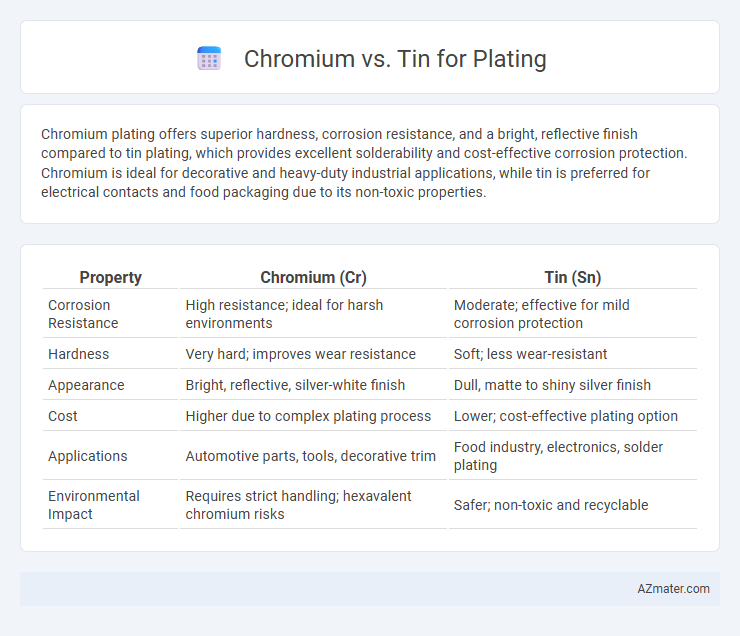Chromium plating offers superior hardness, corrosion resistance, and a bright, reflective finish compared to tin plating, which provides excellent solderability and cost-effective corrosion protection. Chromium is ideal for decorative and heavy-duty industrial applications, while tin is preferred for electrical contacts and food packaging due to its non-toxic properties.
Table of Comparison
| Property | Chromium (Cr) | Tin (Sn) |
|---|---|---|
| Corrosion Resistance | High resistance; ideal for harsh environments | Moderate; effective for mild corrosion protection |
| Hardness | Very hard; improves wear resistance | Soft; less wear-resistant |
| Appearance | Bright, reflective, silver-white finish | Dull, matte to shiny silver finish |
| Cost | Higher due to complex plating process | Lower; cost-effective plating option |
| Applications | Automotive parts, tools, decorative trim | Food industry, electronics, solder plating |
| Environmental Impact | Requires strict handling; hexavalent chromium risks | Safer; non-toxic and recyclable |
Introduction to Metal Plating: Chromium vs Tin
Chromium plating offers exceptional hardness, corrosion resistance, and a bright, reflective finish, making it ideal for automotive parts and decorative applications. Tin plating provides excellent solderability, corrosion protection, and a cost-effective solution mainly used in electronics and food packaging industries. Selecting between chromium and tin plating depends on the specific requirements for durability, conductivity, and aesthetic appeal in the intended application.
Overview of Chromium Plating
Chromium plating offers exceptional hardness and corrosion resistance, making it ideal for automotive parts, tools, and decorative applications. Its high reflectivity provides a bright, mirror-like finish that enhances aesthetic appeal while protecting the underlying metal from wear and oxidation. Chromium's durability outperforms tin in high-temperature and high-friction environments, ensuring long-lasting surface protection.
Overview of Tin Plating
Tin plating provides excellent corrosion resistance and electrical conductivity, making it ideal for protecting steel and copper components in electronics and food packaging. It offers a cost-effective alternative to chromium with superior solderability and a non-toxic surface finish. Tin coatings also prevent oxidation and maintain surface integrity in harsh environments, enhancing the durability of plated parts.
Key Differences Between Chromium and Tin Plating
Chromium plating offers superior hardness and corrosion resistance compared to tin plating, making it ideal for automotive and industrial applications where durability is crucial. Tin plating provides excellent solderability and electrical conductivity, preferred in electronics and food industry components due to its non-toxicity and resistance to corrosion by acidic substances. The main differences lie in chromium's high wear resistance and aesthetic shine versus tin's affordability and effective protection against oxidation in low-stress environments.
Durability: Chromium vs Tin
Chromium plating offers superior durability due to its hardness and resistance to corrosion, making it ideal for high-wear applications and environments exposed to moisture or chemicals. Tin plating provides moderate protection against corrosion but is softer, making it less resistant to abrasion and mechanical damage. The enhanced hardness and corrosion resistance of chromium result in longer-lasting coatings compared to tin, especially in demanding industrial or automotive uses.
Corrosion Resistance Comparison
Chromium plating offers superior corrosion resistance due to its dense, hard surface and excellent resistance to oxidation, making it ideal for harsh environments and automotive parts. Tin plating provides good corrosion protection primarily in mild conditions and offers excellent solderability, widely used in electronics and food packaging industries. While chromium excels in durability against rust and chemical exposure, tin's corrosion resistance is more suited for applications requiring non-toxic and conductive coatings.
Applications in Industry
Chromium plating is widely utilized in automotive and aerospace industries for its outstanding corrosion resistance and high hardness, enhancing durability in engine components and aircraft parts. Tin plating finds extensive use in electronics and food packaging due to its excellent solderability and non-toxic properties, protecting sensitive circuits and preserving canned goods. Both materials serve critical roles in manufacturing, with chromium excelling in structural applications and tin dominating in protective coatings where electrical conductivity and food safety are priorities.
Cost Analysis: Chromium vs Tin Plating
Chromium plating generally incurs higher costs due to expensive raw materials and energy-intensive processes, while tin plating offers a more economical alternative with lower material and operational expenses. Tin plating provides cost-effective corrosion resistance and solderability, making it suitable for mass-produced electronic components where budget constraints are critical. When budget efficiency is prioritized, tin plating is often favored over chromium despite chromium's superior hardness and aesthetic appeal.
Environmental and Safety Considerations
Chromium plating often involves hexavalent chromium, a highly toxic substance posing significant environmental and health risks, including carcinogenicity and water contamination. Tin plating, being less hazardous, offers a safer alternative with minimal environmental impact and lower toxicity. Regulatory agencies increasingly restrict chromium use, making tin plating preferable for applications prioritizing sustainability and worker safety.
Choosing the Right Plating: Factors to Consider
Selecting between chromium and tin plating depends on factors such as corrosion resistance, wear resistance, and application environment. Chromium plating offers superior hardness and aesthetic appeal, making it ideal for decorative and high-wear surfaces, while tin plating provides excellent solderability and corrosion protection in electronic components and food-related applications. Cost considerations, substrate compatibility, and required thickness also influence the optimal choice for plating performance.

Infographic: Chromium vs Tin for Plating
 azmater.com
azmater.com